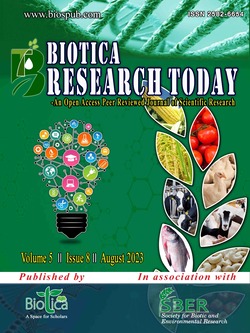
Membrane Bioreactor (MBR) for Transforming Fish Processing Wastewater into Valuable Resources
Ritika A. Tandel*
Dept. of Fish Processing Technology, College of Fisheries Science, Kamdhenu University, Veraval, Gujarat (362 265), India
Jayesh R. Mer
Dept. of Fish Processing Technology, College of Fisheries Science, Kamdhenu University, Veraval, Gujarat (362 265), India
Jitesh B. Solanki
Dept. of Fish Processing Technology, College of Fisheries Science, Kamdhenu University, Veraval, Gujarat (362 265), India
Vivek R. Tandel
Dept. of Aquatic Environment Management, College of Fisheries Science, Kamdhenu University, Veraval, Gujarat (362 265), India
DOI: NIL
Keywords: Fish processing, Membrane bioreactor, Sustainability, Wastewater treatment
Abstract
Water is absolutely necessary for all living things to survive. The fish processing industry generates large volumes of wastewater containing organic solids, disease-causing agents, phosphates and nitrates, posing environmental pollution and biohazard risks to both populations and ecosystems. Membrane Bioreactor (MBR) technology has emerged as an innovative and effective solution for treating fish processing wastewater, mitigating its environmental impact. The high-quality effluent produced by MBRs, which combines biological treatment and membrane filtration, is ideal for reuse applications. The reuse of the MBR-treated effluent for industrial processes, irrigation, or direct discharge into delicate ecosystems can all be done safely while encouraging the protection of water resources.
Downloads
not found
Reference
Andersen, M., Kristensen, G.H., Brynjolf, M., Grüttner, H., 2002. Pilot-scale testing membrane bioreactor for wastewater reclamation in industrial laundry. Water Science and Technology 46(4-5), 67-76. DOI: https://doi.org/10.2166/wst.2002.0553.
Cicek, N., Franco, J.P., Suidan, M.T., Urbain, V., 1999. Effect of phosphorus on operation and characteristics of MBR. Journal of Environmental Engineering 125(8), 738-746. DOI: https://doi.org/10.1061/(ASCE)0733-9372(1999)125:8(738).
Islam, M.S., Khan, S., Tanaka, M., 2004. Waste loading in shrimp and fish processing effluents: potential source of hazards to the coastal and nearshore environments. Marine Pollution Bulletin 49(1-2), 103-110. DOI: https://doi.org/10.1016/j.marpolbul.2004.01.018.
Kitanou, S., Ayyoub, H., Touir, J., Zdeg, A., Benabdallah, S., Taky, M., Elmidaoui, A., 2021. A comparative examination of MBR and SBR performance for municipal wastewater treatment. Water Practice and Technology 16(2), 582-591. DOI: https://doi.org/10.2166/wpt.2021.016.
Millanar-Marfa, J.M.J., Corpuz, M.V.A., Borea, L., Cabreros, C., De Luna, M.D.G., Ballesteros, F.J., Vigliotta, G., Zarra, T., Hasan, S.W., Korshin, G.V., Buonerba, A., Belgiorno, V., Naddeo, V., 2022. Advanced wastewater treatment and membrane fouling control by electro-encapsulated self-forming dynamic membrane bioreactor. npj Clean Water 5(1), 38. DOI: https://doi.org/10.1038/s41545-022-00184-z.
